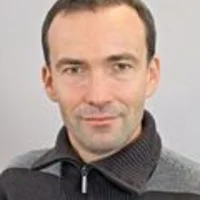In neutron imaging the 2D distribution of the transmitted neutron beam intensity through a sample is measured. The illuminating neutron beam - almost parallel but slightly divergent - has an area of a few cm2 up to 30 x 30 cm2. The imaging detectors used are area detectors covering the illuminated sample area. In most cases this is a combination of a scientific CCD or CMOS digital camera system looking onto a thin neutron scintillator screen. Alternatively amorph-Si flatpanel detectors equipped with a neutron scintillator or neutron imaging plates can be used. Nowadays analog i.e. film based methods almost disappeared. The neutron scintillator converts neutron flux into light emission. The most important detection reactions are (for thermal and cold neutrons):
6Li + 1n → 3H + 4He + 4.79 MeV
10B + 1n → (07%)7Li + 4He + 2.78 MeV
10B + 1n → (93%)7Li* + 4He + 2.30 MeV + γ (0.48 MeV)
155Gd + 1n → 156Gd + γ + conversion electrons (7.9 MeV)
157Gd + 1n → 158Gd + γ + conversion electrons (8.5 MeV)
113Cd + 1n → 114Cd + γ + conversion electrons
Thereby emitted charged particles induce light emission in the scintillators phosphor e.g. ZnS:Ag. Light intensity is rather low - e.g. more like a candle than a light bulb - due to the low brightness of the neutron source. Therefore scintillator efficiency is most important. A combination of high neutron absorption capacity inducing strong light emission in a rather thin scintillator layer is optimal. Scintillator thickness may limit the effective spatial resolution. As a rule of thumb you can expect: best effective pixel size is about twice the scintillator thickness. Typical scintillator thicknesses available are in the range 10 µm - 300µm. The thinner a scintillator the less light emission and consequently longer camera exposure times are required.
Camera detector systems
| Camera | Type | Pixels | Dynamic Range | Application |
|---|---|---|---|---|
| DV434 | CCD | 1024 x 1024 | 16bit | NR / NT |
| iKon-L | CCD | 2048 x 2048 | 16bit | NR / NT |
| DW436 | CCD | 2048 x 2048 | 16bit | micro-NT |
| PIMAX | int CCD | 1340 x 1300 | 16bit | Dynam series |
| PCO4000 | CCD | 4008 x 2672 | 14bit | Dynam series |
| Neo sCMOS | CMOS | 2160 x 2560 | 16bit | Dynam series / NT |
SINQ - call for proposals I-26
proposal submission deadline: 15 January 2026
The Digital User Office will be open for proposal submission approximately 4-5 weeks before the deadline. Of course editing and saving of proposals is possible any time.
